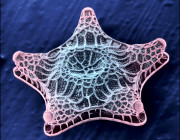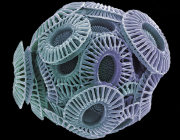Home :: List of Publicly Available Datasets :: Emiliania huxleyi 374
Emiliania huxleyi 374
Downloads:
| Principle Investigator(s) | Kay Bidle |
|---|---|
| External sample ID | Ehux374C24 |
| NCGR Sample ID | MMETSP1007 |
| Sample accession number | CAM_SMPL_002667 |
| Assembly accession number | CAM_ASM_000485 |
| Combined Assembly Name | Emiliania-huxleyi-374 |
| Genus | Emiliania |
| Species | huxleyi |
| Strain | 374 |
| Clonal | Unknown |
| Axenic | No |
| Prelim. NCBI Taxon ID | 2903 |
| 18S rRNA | |
| Importance of organism and transcriptomes | The coccolithophore Emiliania huxleyi forms massive annual spring blooms in the North Atlantic that are routinely infected and terminated by lytic, double-stranded DNA containing Coccolithoviruses. Given the wide array of sensitive and resistant host strains in culture, along with a number of genetically diverse E. huxleyi-infecting viruses (EhVs), the E. huxleyi-EhV host-virus system has emerged as one of the best model systems to investigate host-virus interactions and the cellular processes mediating infection dynamics. However, little is known about the molecular mechanisms mediating phytoplankton host-virus interactions. This project aims to sequence transcriptomes for both uninfected (control) and EhV86-infected E. huxleyi strains that span a range of viral susceptibility in order to elucidate the comparative global, subcellular transcriptional response associated with either resistance or sensitivity to infection. Transcriptome datasets will consist of control and EhV86-infected cells for the hyper-resistant strain CCMP379 (Ehux379) and the hypersensitive strain CCMP374 (Ehux374) at 2 h and 24 h of lytic infection. This information will shed novel insight into the subcellular mechanisms of resistance and sensitivity, thereby allowing us to better elucidate the evolutionary relationship between E. huxleyi and its viruses. It may also reveal unprecedented molecular insight into a possible innate immune response to protect against infection and ultimately influence which strains escape viral demise. Aside from a few isolated genes in GenBank [putative calcium binding protein (gpa), cytochrome oxidase (coi) and actin], no transcritomic information is currently available for Ehux379 or Ehux374 strains. Hence, these transcriptomic datasets will not only provide novel inter-strain comparisons for global gene expression response to virus challenge, but they will also provide data for an extensive dataset for comparison with the available ESTs (which include EhV-infected cells) and the reference genome information for E. huxleyi CCMP1516 (http://genome.jgi-psf.org/Emihu1/Emihu1.home.html), which is also sensitive to EhV infection. |
| Additional citations and references | |
| Environmental Data | |
| Latitude | 42.5 |
| Longitude | -69 |
| Depth (m) | 5 |
| Collection date | 23-JUN-89 |
| Sample collection site | OTHER |
| Other collection site info | Gulf of Maine |
| Sample material (e.g. "seawater," "sediment," etc.) | seawater |
| ENVO term for habitat - primary term | Acquatic: marine |
| Habitat | marine habitat |
| Country | UNITED STATES |
| Experimental Data | |
| Date of experiment | 01-AUG-11 |
| Growth medium | f/2 - Si amended seawater |
| Modifications to growth medium | f/2 for all nutrients except silica, which was not added |
| Temperature (ºC) | 18 |
| Salinty (psu) | 20 |
| pH | 8.3 |
| Light (µmol photons / m2 / sec) | 200 |
| Day portion of day:night cycle in hours | 14 |
| Night portion of day:night cycle in hours | 10 |
| Nitrate (μmol/L) | 883 |
| Phosphate (μmol/L) | 36.2 |
| Trace elements (total) (nmol/L) | 1200 |
| Investigation type | Eukaryotes |








